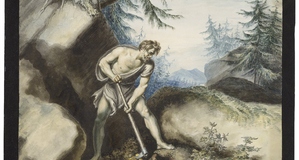Fate, Fortune, and Timon of Athens: Reinterpreting The Senecan Chorus
By
2012, Vol. 4 No. 01 | pg. 1/1
KEYWORDS:
In Seneca's tragedies, the Roman playwright and philosopher employed the concept of fate and fortune to structure the outcome of characters' lives. Frederick Kiefer notes in Fortune and Elizabethan Tragedy that the Senecan chorus primarily discusses the characters’ actions and world in relation to the paradox of Stoicism. In this paradox, two oppositional forces comprise the universe: fate structures one part with logic, meaningfulness, and organization, which the chorus requires man to adhere with, while fortune structures the other part with volatility, danger, and change, which the chorus requires man to oppose (61). In the tragedy The Life of Timon of Athens, Shakespeare reinterprets the dramatic tradition of the Senecan chorus with the character Apemantus; Apemantus discusses how the other characters’ actions accord with fortune, while the style and structure of his speech (1.2.58-71) depicts that he accords with fate. Employing allegory, epanaphora, feminine line, rhyming couplet, trochaic inversion, pleonastic doublet, and apocope, Apemantus' speech characterizes him as a moral Senecan chorus who condemns the inverted nature of friendship in Athens because it accords with sin and fortune, so he attempts to accord Timon with fate by satirizing how friendship is a disguise for materialistic gain. By analyzing the internal structure and style of Apemantus' speech (1.2.58-71) that employs allegory, epanaphora, feminine line, rhyming couplets, trochaic inversion, pleonastic doublet, and apocope, Apemantus' characterization illustrates his moral lifestyle, which aligns with fate, and juxtaposes that with the inverted nature of friendship in Athens, which aligns with sin and fortune, to satirize the disguises Timon’s friends employ for materialistic gain. By juxtaposing one lifestyle based upon friendship and the other on self-reliance, Apemantus' speech depicts that the former's utilization of avarice, sycophancy, and prodigality invert the nature of friendship for material gain as sinful, while the latter illustrates that avoiding the dangers of having to trust men’s honesty for material gain leads to a simplistic and moral lifestyle. By correlating a feast with pride and sin, Apemantus’ grace satirizes how friendship allows friends to exploit each other for materialistic gain and attempts to accord Timon with fate: Here’s that which is too weak to be a sinner, The context for Apemantus’ grace presents an allegory that constructs Apemantus' lifestyle as one that relates what he drinks and eats to how he acts towards others. By associating himself with morality and juxtaposing that with sin and therefore fortune, he establishes himself as a moral character who speaks with honesty, leads a simplistic lifestyle, and avoids deceiving others to accord with fate. Written in iambic pentameter, scansion reveals this allegory in Apemantus' speech (1.2.58-61) in the two trochaic inversions on “honest” and “water”, personifying water as a moral, undisguised, and truthful person, who cannot sin according to the apocope on “ne'er”. Applying his drink and its personification to the pronoun “this”, the stresses on “and”, “food”, and “equals” suggest that both his drink and food are simple and that that simplicity is representative of his moral personality and lifestyle. This exemplar of a moral lifestyle accords with fate and not sin because the trochaic inversion on “feasts”, the stress on “pride”, and the rhyming couplet of “odds” and “gods” suggest that feasts are a representation of avariciousness, prodigality, and sin because feasts reflect gluttony which contrasts Apemantus’ food or drink. Therefore feasts are a sinful materialistic representation of prodigality and gluttony. Constructing himself as a moral Senecan chorus, Apemantus gives advice to attempt to accord Timon with fate by following Apemantus’ lifestyle and rejecting Timon’s current lifestyle of sin. Furthermore, Apemantus' grace (1.2.62-71) illustrates the inverted nature of friendship in Athens through satirizing Timon's sycophantic and avaricious friends and Timon’s blindness to their disguises. Apemantus' grace crystallizes him as a moral Senecan chorus when he pinpoints sin as fortune’s inversion of friendship but uses his exemplar lifestyle to represent fate. A.C. Bradley writes in “The Substance of Shakespearean Tragedy” that the main source of torment and death comes from “moral evil”. This “moral evil” is either in the background or the foreground of the play’s actions and events which fuel a tragic outcome (94). Written in iambic tetrameter the stresses on “crave”, “pelf”, “pray”, and “self” create the idea that Apemantus desires not to obtain money by dishonourable means, satirizing the way in which Timon's friends use disguises to obtain his money, and connecting that with a rhyming couplet, Apemantus will not pray for the other Athenians’ sins. This illustrates the “moral evil” of the avaricious and sycophantic Athenians who invert the nature of friendship for personal gain within the play’s thematic foreground of friendship and materialism. The stresses on “never”, “fond”, and “trust” and the pleonastic doublet of “oath or bond” outline how Apemantus’ lifestyle avoids the elements of friendship that become a disguise with which Timon’s friends can manipulate Timon with sycophancy for their avariciousness because Timon mistakes their disguises for true friends, depicting his blindness. Satirically, the speech parallels Timon and his friends' version of friendship through epanaphora with the coordinating conjunction “or” to grammatically link that previous insight with “harlot”, “dog”, “keeper”, and “friends” in a catalogue of denigrating relationships, each of whom has the ability to use a disguise to wield power over an individual. Line 70 and 71 not only indicate how fortune relates to a materialistic version of friendship with stresses on “fall”, “rich”, and “sin” but also relates to the initial context of Apemantus’ speech by juxtaposing wealth and sin with the stress on “root” that symbolizes Apemantus’ moral and natural lifestyle that accords with fate, satirizing the disguises of Timon’s friends to attempt to accord Timon with fate. The scene structure of Act 1 portrays Apemantus as a moral Senecan chorus who condemns the inverted nature of friendship and its relationship with fortune by satirizing Timon's characterization to attempt to accord him with fate by elucidating Timon's friends' avariciousness and sycophancy. How the scene structure of Act 1 focuses on a specific sequence and selection of events highlights Apemantus' character as a moral Senecan chorus because he condemns the sycophancy of Timon's friends; in contrast, Timon’s characterization accepts his friends' flattery and provides them with a feast, highlighting Timon's blindness to his friends' avariciousness and his prodigality. During the first banquet scene Timon says, “where there is true friendship...more welcome are ye to my fortunes / than my fortunes to me” (1.2.18-20); this characterizes him as blind to his friends' sycophancy and avariciousness, unaware of the inverted nature of friendship, and dependent upon a lifestyle of prodigality because he views friendship in terms of materialism rather than spirituality. Apemantus contrasts Timon’s characterization by warning Timon about his friends' sycophancy, the inverted state of friendship (1.2.34), and how it imparts fortune to attempt to accord Timon with fate. Apemantus satirizes Timon and his friends saying he will never be a flatterer because flattery is not the base of true friendship but rather a way to Timon’s undoing (1.2.39-49). In Shakespeare's Tragic Heroes: Slaves of Passion, Lily Campbell argues that the Renaissance idea of tragedy became a way in which one sought an answer for the evils done to men, and eventually, man's desires became the folly brought upon one's self because one’s desires became the root of evil, allowing fortune to represent a change from joy to misery (22). Timon's desire to bestow wealth depicts his prodigality and nurturance of his friends avariciousness because he has no family but friends “like brothers” (1.2.104); because Timon desires friendship, he treats his friends like family, and they become his “root of evil”, placing too much trust in them and allowing fortune to later change him. Similarly, in Hamlet, Hamlet desires revenge and that becomes his root of evil, allowing fortune to change him to achieve his revenge. While achieving his revenge, the murder of Polonius creates a desire for revenge in Laertes, for whom revenging his father’s death also becomes his root of evil, changing him, too. Both Timon and Hamlet’s desires become their roots of evil, and because desire accords with the dangers of fortune, their lives change according to fortune’s whims, resulting in death. The scene structure of Act 1 portrays Apemantus as a moral Senecan chorus who condemns the inversion of friendship and its relation to fortune by satirizing Timon's characterization as a prodigal and blind to how friendship is a disguise used for material gain to accord Timon with fate. In its symmetrical opposite, the second banquet scene (3.5) illustrates that Timon has undertaken Apemantus’ advice in an attempt to accord with fate by condemning how his friends use friendship as a disguise for materialistic gain, resolving the play. Although Apemantus is not present in this scene, the change in Timon's characterization clearly depicts that Timon sees the inversion of friendship and his friends' use of sycophancy; Timon’s fall by fortune, however, resolves the play by the conventions of tragedy. After seating senators and lords for another feast, Timon serves his guests plates of warm water while calling them “parasites”, “fools of fortune”, and satirically offers them money (3.6.85-100). Timon's characterization suggests that he is no longer a prodigal, blind to his friends' avariciousness and sycophancy, and unaware of the inverted nature of friendship. Apemantus' advice penetrates Timon, and Timon becomes independent from the inverted nature of friendship, realizing that it accords with fortune. Timon's biggest change, however, comes when he moves from one extreme of humanism to the other of misanthropy. Tom McAlidon supports this characterization in “What is Shakespearean Tragedy?” that the occurrence of change comes from the Fall of Princes tradition, and this change affects the hero’s mental, moral, and communicative abilities so that he can no longer coexist in the world because the people he loved, knew, and trusted are now radically different to him (6). Timon’s misanthropy shows that he can neither speak, think, nor believe in the good faith of his friends any longer; he abhors all that is man, including civilization. By leaving Athens, Timon undergoes this change because his desire for friendship and his “root of evil” constitute a change meaning he is not in harmony with people nor the world. Timon's suicide (5.1) means that Timon’s characterization must progress from prodigal, to misanthropic, and to suicidal to resolve the play. In “Seneca and the Stoic Hero,” Geoffrey Miles explains the act of suicide: “Dignitas” refers to suicide as an honourable act wherein a person remains true to their principles out of self-respect, meaning Shakespeare’s Roman characters commit suicide because it suits their characterization accurately (286). Because the sequence of events causes Timon to become misanthropic, his suicide adheres to the conventions of tragedy producing A.C. Bradley’s “tragic outcome” (94) of the play and remaining true to his beliefs of misanthropy which reflect “Dignitas”. Likewise in The Tragedy of Julius Caesar, Marcus Brutus commits suicide because he loses the battle with Antony and Octavius and the principles with which he warred for can no longer be upheld, so his suicide is a way to preserve the principles of self-respect and honour. Both Timon and Brutus illustrate how changes in their societies force them to commit suicide by “dignitas” because of their characterizations. When Timon finally utilizes Apemantus' advice, falls by fortune’s wheel, and rebuffs the inverted nature of friendship, he coincides with the conventions of tragedy and the ritual of Roman suicide to resolve the play, and this characterizes the moral Apemantus as a reinterpretation of the Senecan chorus because he provides information attempting to accord Timon with fate by satirizing how friendship is a disguise for materialistic gain. When Apemantus gives his speech in Act 1, Scene 2, the internal structure, the figures of speech, and the style in which they are written characterize Apemantus with vital information to the play’s resolution. As a moral Senecan Chorus and because Timon of Athens is thematically concerned with how friendship can be manipulated for material gain, Shakespeare utilizes Apemantus as a vessel to both attempt to save Timon, for whom pathos is in excess, and to satirize the insidious nature of humans when they exploit their friends for materialistic gain. ReferencesBradley, A.C. “The Substance of Shakespearean Tragedy.” Shakespearean Criticism. Ed. Michelle Lee. Vol. 125. Detroit: Gale Cengage Learning, 2009. 83-206. Literature Criticism Online. Gale. York University Libraries. 29 June 2011. http://galenet.galegroup.com.ezproxy.library.yorku.ca/servlet/LitCrit/yorku_main/FJ1581350003. Campbell, Lily B. Shakespeare’s Tragic Heroes: Slaves of Passion. New York: Cambridge UP, 1963. Print. Kiefer, Frederick. Fortune and Elizabethan Tragedy. San Marino: Huntington Library, 1983. Print. McAlindon, Tom. “What is Shakespearean Tragedy?” The Cambridge Companion To Shakespearean Tragedy. Ed. Claire McEachern. Cambridge: Cambridge UP, 2002. 2-16. Print. Miles, Geoffrey. “Seneca and the Stoic Hero.” Shakespearean Criticism. Ed. Michelle Lee. Vol. 111. Detroit: Gale, Cengage Learning, 2008. 261-354. Literature Criticism Online. Gale. York University Libraries. 29 June 2011. http://galenet.galegroup.com.ezproxy.library.yorku.ca/servlet/LitCrit/yorku_main/FJ2854250005. Shakespeare, William. “The Life of Timon of Athens.” The Riverside Shakespeare. Ed. G. Blakemore Evans, 2nd ed. Boston: Houghton Mifflin Company, 1997. 181-205. Print. Suggested Reading from Inquiries Journal
Inquiries Journal provides undergraduate and graduate students around the world a platform for the wide dissemination of academic work over a range of core disciplines. Representing the work of students from hundreds of institutions around the globe, Inquiries Journal's large database of academic articles is completely free. Learn more | Blog | Submit Latest in Literature |
















